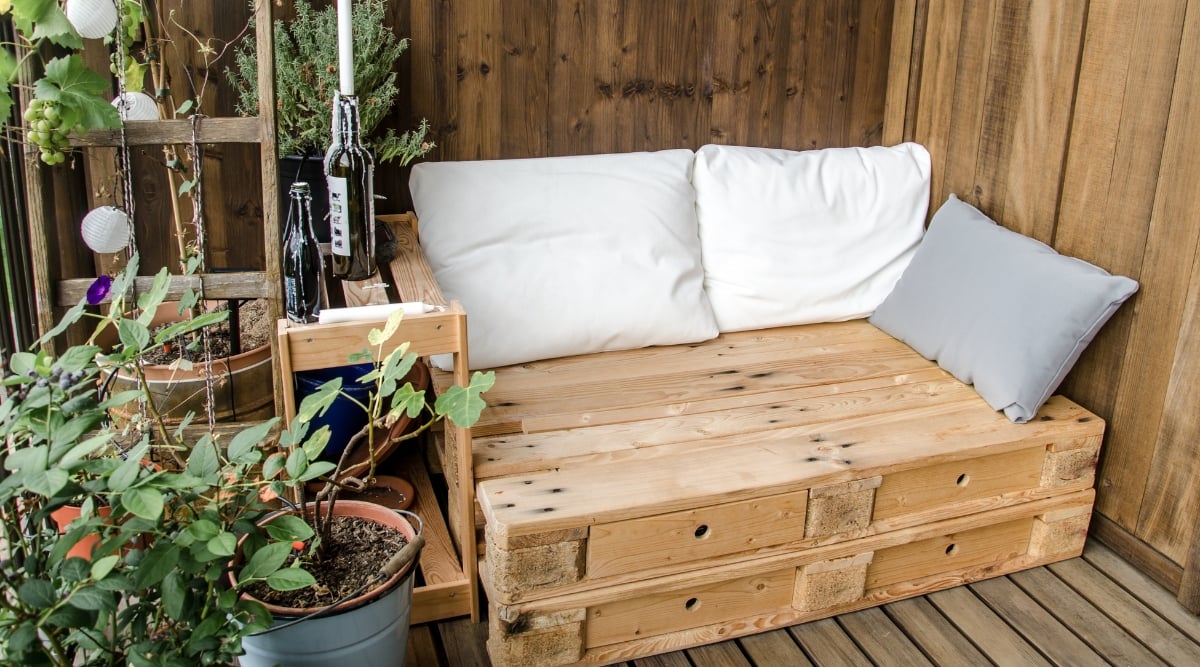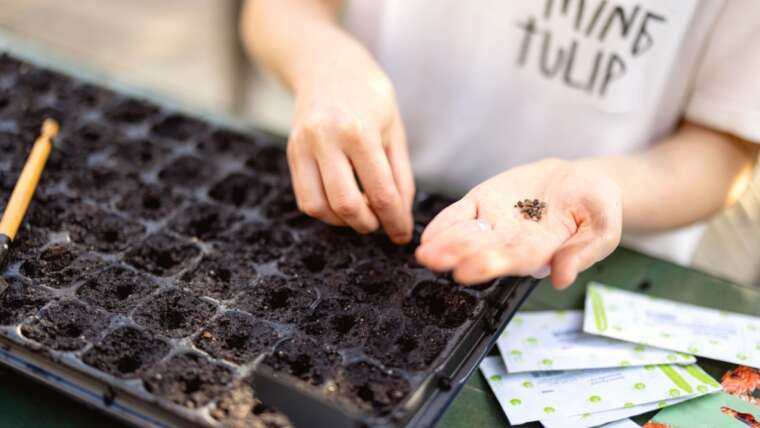Considering the meteoric rise of city living, it’s no surprise that interest in balcony gardens has steadily increased over the past few years. Although the environments can be more demanding, balconies offer apartment dwellers the opportunity to grow almost anything without an inch of backyard space.
It is possible to grow an abundance of plants on a balcony, but careful planning and a few tricks will ensure you make the most of a small space.
Use these tips to help maximize your balcony garden space, growing whatever your heart desires.
Start Small
Start your patio garden with a few easy-to-manage plants first.
When you first create a balcony garden, instantly filling the space with greenery can be tempting. All the inspirational pictures of balcony gardens packed with plants online certainly don’t help the urge.
However, it’s far better to start small and work your way up – especially when space is a concern. Balcony gardens are notoriously tricky environments, battling wind, high temperatures, and (by Murphy’s law) either scorching sun or no sun. You don’t want to blow your garden budget on masses of plants only to find them mostly dead by the end of the month.
If you’re new to gardening or don’t have the time to invest in meticulously caring for your plants daily, ‘go big or go home’ is not the approach. Start with a few plants that are manageable and easy to grow, and work your way up as you get the hang of their care.
That’s not to say you should never fulfill your balcony jungle goals. With the right systems in place, nothing stops you from making the most of a small space while maximizing plants. But pick a couple of plants first – you’ll be surprised how much of a difference they make to the area without overwhelming it.
Choose Containers Carefully
 You need to consider several different factors before potting your balcony plants.
You need to consider several different factors before potting your balcony plants.
While choosing your plants may be the most exciting aspect of getting started, choosing the proper containers is equally essential. Not only does container choice impact the health of your plants, but it also impacts the usage of space and safety of your balcony garden.
When choosing containers for a balcony garden, there are a few criteria that should be top of mind:
Drainage
 Proper drainage is essential to keep your plants from developing root rot.
Proper drainage is essential to keep your plants from developing root rot.
Before anything else, ensure your chosen container has drainage holes in the bottom. Drainage is essential to allow excess moisture to leave the container, allowing air to flow around the roots and preventing root rot.
Although quick-drying soil makes drainage less of a concern than it may be for things like houseplants, it is still a feature that cannot be forgotten if you want to keep your balcony garden plants alive long-term.
Many decorative containers don’t come with drainage holes. As tough as it may be, it’s best to avoid these – no matter how much they match your balcony garden design. You can drill your own holes in the base of the pot, but it’s best to pick containers with built-in drainage so you can be confident your plants won’t suffer.
Materials
 Choose containers that will be lightweight and easy to move around if needed.
Choose containers that will be lightweight and easy to move around if needed.
The next concern is materials. Different materials influence plant health differently, but these can generally be managed to keep your plants happy. Instead, a balcony garden should focus on weight and moveability.
Balcony gardens evolve over time. You can swap out a plant or move a container to a better spot to make the most of the sunlight. This impermanence means the ability to move your containers easily is vital to maximizing space.
Rather than setting a large container in a spot and forgetting about it, you should be able to shift plants around to improve care and make the best possible use of space.
Weight is another consideration for safety purposes. Containers, soil, plants, and regular watering add plenty of weight pressure to the structure of your balcony. Lighter pots made of fabric or plastic like plastic are preferable to heavy materials like ceramic or terra cotta.
Dimensions
 Consider space-saving containers over round pots that take up more precious square footage.
Consider space-saving containers over round pots that take up more precious square footage.
The final consideration is dimensions. Your starting point should be how much space your chosen plants need to grow. But if you’re looking to maximize space, shape and size play a role.
While standard round pots are the most easily accessible, they aren’t the most practical for space saving. If you’re planting multiple plants in the same container – like building an herb garden, for example – a long, rectangular planter may better use balcony space than grouping several round pots.
Changing up shape and size also creates visual interest in your balcony garden, making it look less one-note.
Grow Vertical
 Vertical gardens are the perfect solution for small patio spaces.
Vertical gardens are the perfect solution for small patio spaces.
Limited floor space doesn’t mean limited growing space. The first tip you’ll notice when researching space saving in the garden, not just balcony gardens, is growing vertically.
Walls and overhead space often stay empty on balconies, with gardeners prioritizing easy-to-fill floor space. But this misses out on several levels of greenery that come with so many benefits:
- You’re using space that can’t be filled by much else.
- You surround yourself with plants from all sides rather than sticking to eye level.
- Vertical gardens draw the eye around the space and make it look larger.
- You leave gaps for other balcony elements like bistro sets or potting tables, preventing overcrowding.
Once you use your vertical space, you double or triple your growing area without blocking usable floor areas. Plus, there are so many ways to garden vertically that there’s no excuse not to try it.
A simple solution is wall mounts or trellises with a few small containers attached. For something a little more advanced, you can invest in vertical planters. Also, add a few hanging baskets overhead, and you’ll have more planting space than you know what to do with.
Get Creative
 Repurposing and DIYs save money and create a custom, unique-looking space.
Repurposing and DIYs save money and create a custom, unique-looking space.
Creativity is an important skill when designing a balcony garden to maximize space. Sticking to tried and tested layouts isn’t bad, but it also doesn’t consider the structure and layout of your particular balcony. In these cases, a little creativity goes a long way.
This can mean a few things, depending on what you want to focus on. It could involve planting exciting combinations of plants together in the same container to save space and boost visual interest. For DIY lovers, you can build your own planters to perfectly fit your space or recycle old materials to bring new life to them.
To use vertical space and upcycle, I painted an old ladder and set it up on my balcony, filling the steps with many small containers. Although the look was quite rustic, it came to life once the plants filled out and didn’t take up much floor space.
The best part of putting a balcony garden together is playing around. Be open to new ideas and try different combinations to maximize your existing space.
Care Comes First
 Be prepared to water your balcony plants more often than your typical houseplant.
Be prepared to water your balcony plants more often than your typical houseplant.
Aesthetics is a concern when designing a balcony garden. We don’t want to work to create a space that doesn’t look good or that we don’t want to spend time in. When choosing plants, we cannot forget the importance of good care.
Balcony container gardens require more attention than others due to the potentially harsh environments. Lighting, wind, and temperatures can be a battle, depending on where you live. Extra care is critical when it comes to watering. While you may water your houseplants around once a week or less, balcony gardens may need water as often as every day during the peak of summer.
When you first purchase your plants and place them on your balcony, they will undoubtedly look good. But the right environment and regular care are essential to keep them looking that way. When choosing your plants, make sure to pick ones that suit your climate, the orientation of your balcony, and your intended maintenance schedule.
Pick plants you know will thrive in that environment to make the most of the balcony garden space without struggle.
Choose Dwarf Varieties
 Dwarf plant varieties are a perfect option when space is limited.
Dwarf plant varieties are a perfect option when space is limited.
It can be tough to choose between plants with limited space. This is especially true when growing edible plants that often need room to grow to their full potential and produce delicious fruits.
Luckily, growers have come to the rescue. You don’t need to agonize over plant decisions in small spaces when you choose dwarf varieties. Often called ‘patio’ varieties, these plants are designed for growing in small areas, allowing you to maximize production in a small space.
If you want to grow the perfect tomatoes but don’t have room for an indeterminate variety growing several feet tall, something like ‘Cherry Falls’ is a great option. Similar compact types exist for cucumber lovers or squash fans, making the most of the balcony garden room. You can even look for container seed collections with various plants ideal for small spaces.
When you pick suitable varieties, you can limit the compromises required when choosing your plants. In this way, you really can have it all.
Planning Is Key
 Planning ahead gets better results in any garden space.
Planning ahead gets better results in any garden space.
I think a lot of gardening (perhaps more than I’d like to admit) happens on impulse. I see an empty corner that could use some greenery or spot a new variety online I must have, and immediately spring into action.
Unfortunately, that impulsiveness isn’t helpful when working in small spaces. Planning and attention to detail are the only ways to make the most of your balcony before you purchase any supplies.
Always start by measuring your space and deciding what you want to get out of it. To go the extra mile, you can draw a layout of your balcony, changing furniture and plants around until you find the perfect combination that maximizes space. Only then should you head out to start planting.
Rome wasn’t built in a day, and your balcony garden shouldn’t be either. Pull out your tape measure and think carefully before you decide on a final design.
Final Thoughts
You may look at your small balcony and only see limitations to your growing potential. But by following these tips, you’ll create a balcony garden oasis overflowing with plants!




